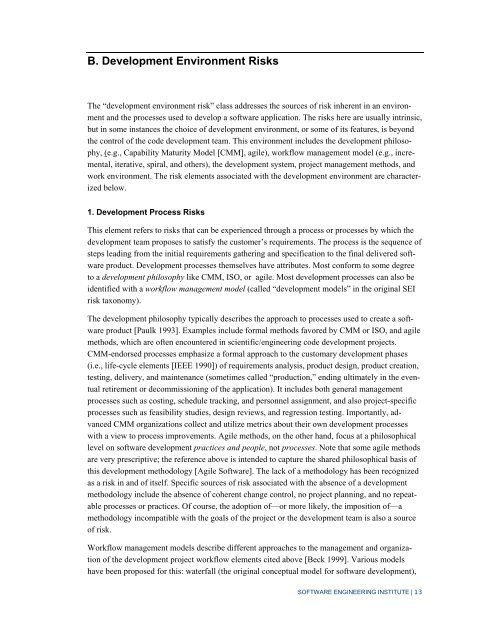A Proposed Taxonomy for Software Development Risks for High ...
A Proposed Taxonomy for Software Development Risks for High ...
A Proposed Taxonomy for Software Development Risks for High ...
You also want an ePaper? Increase the reach of your titles
YUMPU automatically turns print PDFs into web optimized ePapers that Google loves.
B. <strong>Development</strong> Environment <strong>Risks</strong><br />
The “development environment risk” class addresses the sources of risk inherent in an environment<br />
and the processes used to develop a software application. The risks here are usually intrinsic,<br />
but in some instances the choice of development environment, or some of its features, is beyond<br />
the control of the code development team. This environment includes the development philosophy,<br />
(e.g., Capability Maturity Model [CMM], agile), workflow management model (e.g., incremental,<br />
iterative, spiral, and others), the development system, project management methods, and<br />
work environment. The risk elements associated with the development environment are characterized<br />
below.<br />
1. <strong>Development</strong> Process <strong>Risks</strong><br />
This element refers to risks that can be experienced through a process or processes by which the<br />
development team proposes to satisfy the customer’s requirements. The process is the sequence of<br />
steps leading from the initial requirements gathering and specification to the final delivered software<br />
product. <strong>Development</strong> processes themselves have attributes. Most con<strong>for</strong>m to some degree<br />
to a development philosophy like CMM, ISO, or agile. Most development processes can also be<br />
identified with a workflow management model (called “development models” in the original SEI<br />
risk taxonomy).<br />
The development philosophy typically describes the approach to processes used to create a software<br />
product [Paulk 1993]. Examples include <strong>for</strong>mal methods favored by CMM or ISO, and agile<br />
methods, which are often encountered in scientific/engineering code development projects.<br />
CMM-endorsed processes emphasize a <strong>for</strong>mal approach to the customary development phases<br />
(i.e., life-cycle elements [IEEE 1990]) of requirements analysis, product design, product creation,<br />
testing, delivery, and maintenance (sometimes called “production,” ending ultimately in the eventual<br />
retirement or decommissioning of the application). It includes both general management<br />
processes such as costing, schedule tracking, and personnel assignment, and also project-specific<br />
processes such as feasibility studies, design reviews, and regression testing. Importantly, advanced<br />
CMM organizations collect and utilize metrics about their own development processes<br />
with a view to process improvements. Agile methods, on the other hand, focus at a philosophical<br />
level on software development practices and people, not processes. Note that some agile methods<br />
are very prescriptive; the reference above is intended to capture the shared philosophical basis of<br />
this development methodology [Agile <strong>Software</strong>]. The lack of a methodology has been recognized<br />
as a risk in and of itself. Specific sources of risk associated with the absence of a development<br />
methodology include the absence of coherent change control, no project planning, and no repeatable<br />
processes or practices. Of course, the adoption of—or more likely, the imposition of—a<br />
methodology incompatible with the goals of the project or the development team is also a source<br />
of risk.<br />
Workflow management models describe different approaches to the management and organization<br />
of the development project workflow elements cited above [Beck 1999]. Various models<br />
have been proposed <strong>for</strong> this: waterfall (the original conceptual model <strong>for</strong> software development),<br />
SOFTWARE ENGINEERING INSTITUTE | 13
















